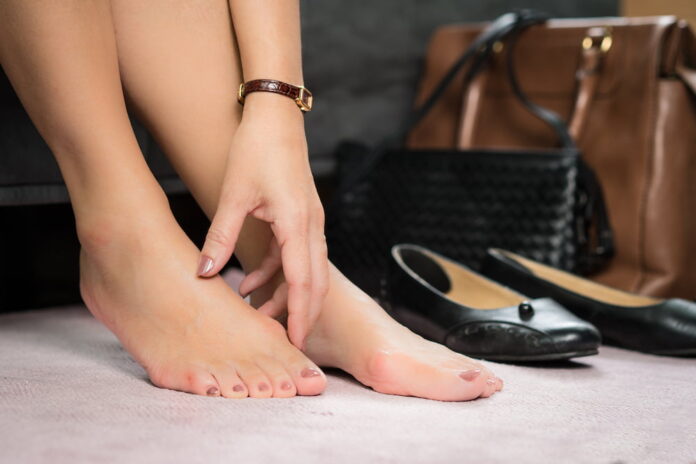Have you ever wondered what the painful bumps that grow on some people’s toes are?
A bunion, medically known as hallux abducto valgus, is a bony bump that forms outside of the big toe when some bones in the front part of your foot move out of place. Bunions develop gradually and are the result of pressure on the metatarsophalangeal joints (or toe knuckles) near the big toe. This pressure stresses the internal tissues, causing the bump to form. The skin around it often becomes sore and red, making movement difficult.
You usually find bunions in older adults, as the feet are often the first to suffer from the effects of wear and tear in aging. They are also common in women, who often have to wear shoes that put stress on the feet.
Aside from being unsightly, these bumps cause a lot of pain when touched. This puts most people with this problem in a dilemma. Choosing between open sandals and form-fitting footwear isn’t something out of which most want to make a big deal.
Fortunately, this problem has many solutions, and can often be prevented in smart, proactive ways. For instance, you can check out professionals like Teton Foot and Ankle, among others, who specialize in podiatric care and intervention to get help. Most of their solutions may require considerable investment. But the protection, support, and comfort you gain for yourself or your loved one make it worthwhile.
To better understand this condition, here’s what you need to know.
What Exactly Causes Bunions?
Like most problems affecting muscles, joints, and bones, bunions usually have practical causes. The biggest culprit is almost always the type and size of shoes you wear. Depending on the shape of your feet and the integrity of your legs, narrow-tipped shoes, high heels, or tight, hard footwear increases the risk of developing bunions.
These types of footwear put pressure on the joints of the feet, which causes pain and malformation. Your risk is also greater if your family has a history of this condition.
So, if you like or must wear sharp, pointed, or high-heeled shoes, you’re bound to get bunions along with many other podiatric issues. These clump or squeeze your toes together, creating the circumstances that lead to their occurrence.
If you’re aware of these risks, you can decrease your odds of getting bunions by reconsidering your shoe sizes and fixing your posture. You should also think of this if you happen to have any of these problems:
– Diseases like arthritis
– Foot injuries
– Genetic foot structure problems, like flatfeet
These conditions exacerbate the development of joint problems. When combined with chronic illnesses, like diabetes, you also get a higher risk of complications. So, you’ll have to work with a specialist to address these issues to make walking and standing easy for you.
How Do You Know If You Have Bunions?
The most obvious sign is the bump that forms around a misshapen big toe. But there are others to look out for. Knowing these earlier may help you seek solutions before the full onset of the condition, improving your chances of fixing it before it gets worse.
These other symptoms may vary from one person to another. Nonetheless, the most common ones are:
– Soreness, redness, or swelling on the area around your big toe
– A bony and bulgy bump on the base of your toe
– Difficulty wearing normal shoes
– Calluses or corns
– On and off pain
– Burning or pain when flexing your big toe
– Numbness on the big toe
– A loss of mobility on the big toe
If you experience any of the above symptoms, you should start taking proactive steps immediately. Start by reaching out to a podiatry expert to learn about the appropriate interventions for foot malformations. If you don’t know where to find one, ask your trusted physician for recommendations or go online.
How Do You Treat Bunions?
The kind of treatment you need depends on the severity of your bunions. For most cases, simple corrective measures are all that’s needed to address the issue. But for chronic ones, where the problem compromises a person’s mobility, you will need a full-on operation.
First, get your foot assessed to learn which method will fix your problems.
Here’s a quick run-through of the common solutions for bunions.
1. Regular Solutions
These are less complicated treatment methods that don’t involve surgery. They help relieve the pain and pressure along with the other symptoms.
After the specialist has examined your foot and formed a diagnosis, they may provide you with the following solutions:
Padding and taping: You can purchase over-the-counter pads or cushions to place around the bunion. This cushions the area, protecting it from impacts and relieving pain. Moreover, it helps reduce friction between your foot and the shoe, keeping it from making movement painful. Apart from the pads, you can also use medical tape to align your foot correctly, especially if you must wear form-fitting shoes. Work with a podiatrist or physical therapist to know the proper way to tape your feet.
Changing your footwear:
If it’s possible, you can always switch out your shoes for wider ones. Try buying those with deep and loose toe boxes to avoid squeezing your toes. The less pressure on them, the better aligned the joints, ligaments, and tissues will be. Make sure that your new footwear remains comfortable for the best results. You can also use a stretching device to make space inside your shoes. But you’ll have to practice caution. Otherwise, you’ll end up ruining your pairs.
Pain relievers:
If your bunions are painful, you can ask your doctor if you can just take painkillers. Nonsteroidal anti-inflammatory drugs (NSAID) can ease pain and reduce swelling. But if you have a different prescription, you must let your prescriber know to prevent harmful drug interactions.
Using ice:
A much simpler way of dealing with bunions is applying ice to them. You should do this after you’ve walked for a long time to reduce the soreness, inflammation, or swelling. Just remember that this only provides relief; you’ll have to receive actual intervention to fix the issue.
Medications:
As mentioned before, medications are a great way to help you maintain your routine while having bunions. Some only relieve either pain or swelling, while NSAIDs do both. Again, make sure to ask your doctor if you can safely take these with your medication regimen. These include:
– Ibuprofen
– Acetaminophen
– Naproxen sodium
Physiotherapy:
Another form of treatment is physical therapy. A PT will use techniques like massages and exercises to help align your toe and increase strength around the affected area. For special programs, they may also use ultrasound therapy to reduce inflammation and pain and break the adhesions around the toe’s soft tissues.
Injections:
A cortisone or steroid injection can reduce inflammation and pain. This method isn’t advisable for regular use because it can damage the joint when done many times.
Orthodontic Equipment:
As a corrective measure, you may get recommendations for over-the-counter personalized shoe inserts to help realign your toes. These devices also help with other alignment issues. Another device that can help you is a spacer that you can place between the second toe and the big one. Try wearing a splint around your toes when relaxing or sleeping to keep the toes tight and avoid squeezing them.
The above treatments can help reduce pain, swelling, and soreness, making it much easier to go about your day even with bunions. Stick to whichever treatment method your doctor recommends to get the results you need.
Read Also
- Why the Keto Diet Works for Some People—and Fails Dramatically for Others: An Ayurvedic Breakdown for Modern HealthcareThe keto diet has dominated weight-loss culture for years. For some people, it produces rapid fat loss, stable energy, and improved mental clarity. For others—especially those who gain weight easily—it leads to burnout, digestive distress, rebound weight gain, high cholesterol, and a metabolism that feels slower than before. Healthcare often frames this as a discipline… Read more: Why the Keto Diet Works for Some People—and Fails Dramatically for Others: An Ayurvedic Breakdown for Modern Healthcare
- How to Choose the Best Assisted Living Facility for SeniorsAre you looking for the right assisted living facility for a senior loved one? Choosing a place can feel overwhelming. There are many factors to consider, from care services to the environment. Safety, comfort, and social opportunities play important roles in daily life. Each senior has unique needs and preferences that must be met. Understanding… Read more: How to Choose the Best Assisted Living Facility for Seniors
- Burn Smart, Not Hard; Shape Burn: Clean Protein for Weight ManagementYou want to feel light, strong, and confident. You don’t want crash diets or fake promises. You need a plan that works with your body, not against it. That’s where Shape Burn comes in. You can burn fat without losing strength. You can eat better and stay full. You can manage weight in a way… Read more: Burn Smart, Not Hard; Shape Burn: Clean Protein for Weight Management
- Creatine Basics: How Much Is 5g, How Much Water You Need, and Whether Pills or Powder Work BetterIf you’ve ever walked into a supplement aisle or scrolled through fitness TikTok, you’ve probably seen people talking about creatine — usually with a shaker bottle in hand and promises of better workouts and faster gains. And honestly? They’re not wrong. Creatine is one of the most researched and effective supplements for muscle strength, recovery,… Read more: Creatine Basics: How Much Is 5g, How Much Water You Need, and Whether Pills or Powder Work Better
- Understanding Breast Cancer in Men: Key Facts and SymptomsBreast cancer is often thought of as a disease that only affects women. However, men can develop it too. Although it is less common, early detection and awareness are important. Read on to learn key facts, symptoms, and ways men can take action to protect their health. How Common Is Breast Cancer in Men? Breast… Read more: Understanding Breast Cancer in Men: Key Facts and Symptoms
2. Surgeries
Specialists may recommend you go through surgery if regular treatment doesn’t help your case. This is especially true if your condition worsens, and you experience pain that keeps you from living independently.
The surgical process of bunion removal is known as a bunionectomy. This procedure aims to:
– Remove the swollen tissue around your big toe
– Realign the bones on the forefoot
– Remove a part of a bone to straighten it or set it back in the proper position
– Correct the angle and placement of the tendons, nerves, and ligaments
– Permanently join the bones around the affected area
If the procedure goes well, it’ll take several days, weeks, or months to recover fully. After that, most patients can walk well, bunion-free. Some additional treatments, like physical therapy or orthotics, can help with providing better results.
How Do You Prevent Bunions?
As mentioned throughout this article, the best way to prevent bunions is to avoid exerting any pressure on your toes by squeezing them or clumping them together. In this regard, choose the correct footwear to keep your feet comfortable and flexible.
If you can, avoid wearing extremely tight shoes or high heels as much as possible. Your attending specialist may provide recommendations for footwear. For example, they may suggest shoes with soft soles and wide toe boxes to give your feet ample room.
Another thing you should do is to exercise and eat healthily to avoid gaining excessive weight. When you have a healthy weight, less pressure is exerted on your toe joints, reducing the chances of getting bunions.
Know What To Do
If you or someone you know is dealing with bunions, you can easily get the solutions you need by reaching out to the right experts. The sooner you get started, the better. If you don’t have them yet, now is the time to re-assess your footwear and routines to avoid problems with your feet. Don’t take your mobility for granted.






